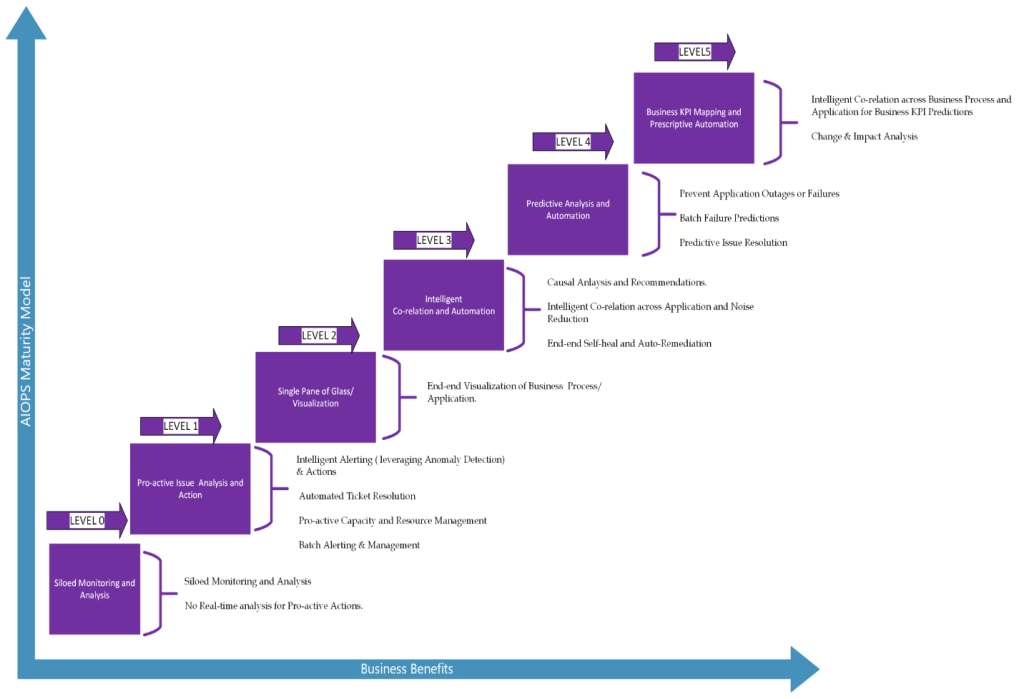What is AIOps ( AI-enabled Operations)?
It’s the application of artificial intelligence, machine learning, deep learning, and big data to manage, automate and improve IT operations.
The latest Gartner report on AIOps reveals that AIOps adoption is increasing across organizations. Organizations are adopting AIOps with different maturity levels across these domains and are increasingly being adopted across application operations, infrastructure operations, Cloud Management, DevOps, Security.
A quick view of the AIOps Maturity and Adoption model below will give you a view of the use-cases being adopted across multiple maturity levels in different organizations.

Organizations have adopted a pragmatic approach and gained initial success in adopting intelligent Alerting for full-stack monitoring, co-relation, and Automated ticket resolution for service management. As referred to in the above maturity model many organizations are already reaping benefits by early adoption of use-cases up to Level 3 of the AIOPS maturity model.
How do organizations move to the next level of AIOPS Adoption and what are the adoption challenges?
Data Siloes don’t help.
Just IT-centric data is not enough… it is critical to bring data from business as well, we need to bring data from DevOps, cloud management, Security as well. for eg: for telecom customers, data from the BSS/OSS systems is critical. For a retailer, data from the supply chain, POS, and warehouse systems are critical. It is important to break these data siloes. Organizations need to enable distributed data and data mesh architectures and enable leveraging existing Data domains for the same. AIOps can be enabled based on co-relating existing data domains and generate new Insights.
Organizations are yet to unleash the power of Data and AI.
It is important to leverage all data small or big to come with Rich AI-based Insights. Mostly the power of algorithms becomes richer with more and more data being leveraged for decision making. Heuristic-based approaches enable us to get the system working quickly, however, the power of data for decision making should be a structured and ongoing effort. Also, AI engineering is not fully operational for many of these systems and hence the power of Data and AI is not fully realized. It is important to put proper AI engineering frameworks and practices in place for Data Operations, Model Operations to enable accurate algorithmic-based decision making.
User Experiences
The single pane of Glass as the silver bullet for all problems AIOps intends to solve has certainly allowed initial adoption. The truth for the users we have not yet allowed the users to be free from the drudgery of data and dashboards. Unless we provide them personalized insights and enable decision-making, users will find it difficult to bite the Silver Bullet. Also, users are increasingly working remotely and with hybrid work becoming the norm, user experience is very critical to higher adoption of AIOps.
IT systems don’t work in isolation. They are part of a complex business landscape driving the digital experiences for customers, employees, and partners. While the power of data can drive Insights, it is the understanding of the business process and application landscape, its impact, and the historical context that helps navigate AIOps enabling complex decisions for businesses for eg: Change Impact analysis or a causal analysis and recommendations. This is also called Observability. Existing tools or frameworks allow us to build this partially because of the operational siloes… Building this context enables us to enable the right decision-making for AIOps thus enabling higher business benefits.
The Holy Grail of AIOps is not right here and right now, but it involves a structured approach to solve these challenges through a coherent enterprise-wide AIOps approach.
How would your enterprise approach this? Would like to know your ideas and suggestions…









